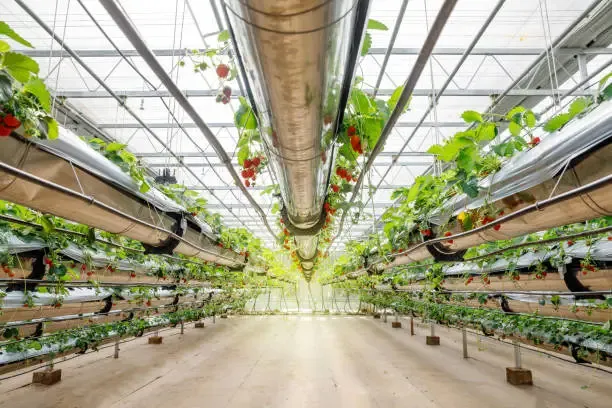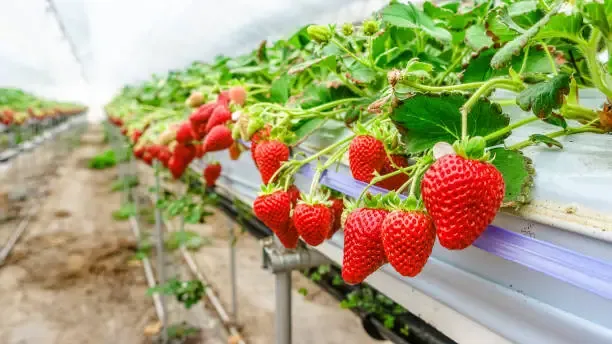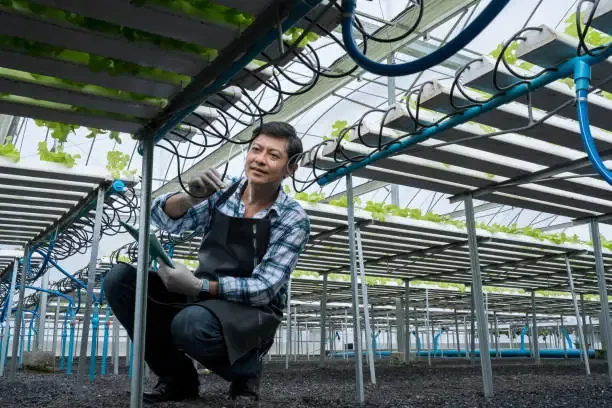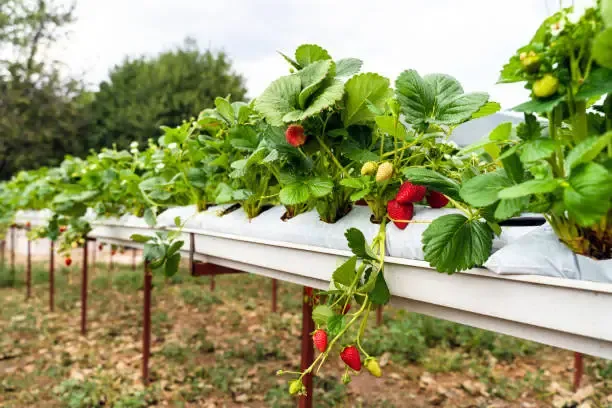Are you a strawberry lover but lack garden space or live in an area with less-than-ideal soil conditions? Fear not! With hydroponic systems, you can grow delicious strawberries right in the comfort of your own home. In this comprehensive guide, we'll walk you through the process of setting up and maintaining a hydroponic strawberry garden, ensuring a bountiful harvest of juicy berries.
Setting up a hydroponic system for strawberries involves several steps to ensure your plants grow healthy and produce tasty fruit.
Nutrient Film Technique (NFT): In this system, a steady stream of nutrient solution moves along a shallow channel, letting the plant roots soak up nutrients while getting enough oxygen. NFT systems are great for strawberries because they give the roots lots of oxygen and help the plants take in nutrients well. Also, the shallow channels help support the way strawberries grow along the ground, making it easier to take care of them and pick the berries.
Vertical Tower System: Vertical hydroponic systems, like tower gardens or vertical grow towers, are really good for growing strawberries too. They have lots of planting pockets stacked on top of each other, which saves space and lets you plant a lot of strawberries close together. Vertical towers work well for strawberries because they give the roots plenty of air, help water and nutrients get to the plants well, and make it easy to take care of and pick the berries.
Both NFT and vertical tower systems are great for growing strawberries hydroponically. They both give the plants nutrients well, make sure the roots have enough oxygen, and save space. But which one you pick depends on things like how much space you have, how much money you want to spend, and what you like.
 |
| Hydroponic Strawberry Farm | Photo Credit: DONOT6 |
How to select Strawberry varieties for Hydroponics System?
Choosing the best kinds of strawberries for your hydroponic garden is really important to get a good harvest. Different kinds taste different, are different sizes, and resist diseases in different ways, which can change how well they grow in a hydroponic system. If you know about the different types of strawberries and what they need, you can pick the ones that will give you the most strawberries of the best quality.Strawberry varieties come in three main types: June-bearing, everbearing, and day-neutral.
- June-bearing strawberries: June-bearing strawberries are a kind of strawberry plant that gives a lot of fruit all at once, usually in June (that's why they're called that!). These plants can handle cold weather and grow for a shorter time than other kinds of strawberries, like everbearing ones. They're often grown in rows with mulch. June-bearing strawberries usually give more fruit that tastes sweeter and better than other kinds. People like them a lot because of how good the fruit is. Unlike everbearing strawberries that make fruit many times a year, June-bearing ones focus on making one big, juicy harvest in early summer!
- Everbearing strawberries: Everbearing strawberries, also called "half-high" or "intermediate day-length" strawberries, are a kind of strawberry plant that gives fruit twice a year. They usually make a small amount of fruit in early summer and a lot more in the fall. Unlike other strawberries, everbearing ones keep making berries all summer long. They like lots of sunlight and need soil that drains well but stays moist. When you plant everbearing strawberries, pick a sunny spot that gets at least six hours of sun every day. In hot and dry places, it's good to shield them from the strong afternoon sun. Before planting, mix in old compost to give them the food they need. Give them enough room to spread out, and you'll have yummy strawberries from your garden or farm!
- Day-neutral strawberries: Day-neutral strawberries are a kind of strawberry plant that makes fruit all through the growing season instead of just at one time. Unlike other strawberries, they don't care how long the days are—they keep making fruit as long as the weather is good. These berries are usually smaller but taste really strong. Some kinds of day-neutral strawberries people like are 'Seascape,' 'Tristar,' and 'Albion.' If you want strawberries from your garden all season, day-neutral ones are a good pick!
Factors to Consider When Selecting Varieties:
- Size and Growth Habit: Consider the size of your hydroponic system and the growth habit of the variety. Some varieties are compact and suitable for small spaces, while others spread out and require more room.
- Taste and Texture: There are lots of kinds of strawberries with different tastes and textures, from sweet and juicy to tangy and firm. Pick the ones you like best or ones that people want to buy.
- Disease Resistance: Try to find kinds of strawberries that don't get sick easily, like powdery mildew and verticillium wilt. These kinds can grow well in hydroponic systems without getting sick as much.
- Yield and Productivity: Check how many strawberries each kind can make to make sure you'll always have enough. Kinds that make a lot of fruit can give you the most strawberries and make your hydroponic setup worth it.
- Environmental Adaptability: Think about the weather where your hydroponic system is. Pick kinds of strawberries that like the temperature and how humid it is where you are.
Read also: Grow onion using Hydroponic System
What is Hydroponic Strawberry Cultivation?
Hydroponic strawberry growing means growing strawberries without using soil. Instead of soil, hydroponic systems give water with important nutrients straight to the roots through tubes or channels. There are two main ways to do this: nutrient film technique (NFT) and deep water culture (DWC). NFT systems have a thin layer of nutrient water running over a material the plants grow in, like rockwool or perlite. DWC systems put the roots right in a tank full of nutrient water. |
| Juicy Strawberries | Photo Credit: bee32 |
Advantages of Hydroponic Strawberry Cultivation:
- Year-Round Cultivation: Hydroponic strawberries let you grow yummy fruit all year round, no matter the season. Unlike regular gardening with soil that changes with the weather, hydroponics gives plants the same conditions all the time, so they grow steadily.
- Space Efficiency: Hydroponic systems are made to use space well. That's why they're great for people who live in cities or don't have a lot of room for gardening. Vertical hydroponic setups make even better use of space by growing plants upwards instead of outwards.
- Precise Nutrient Control: With hydroponics, you get to decide exactly what nutrients the plants get. You can adjust the mix to give strawberries just the right stuff they need to grow the best and make the most fruit.
- Water Conservation: In a world where water is hard to find, hydroponic systems are great because they save water. They use much less water than regular gardening with soil, which is good for the environment.
- Reduced Exposure to Soil-Borne Issues: Hydroponic strawberries don't have to deal with the usual problems that come with soil, like bugs, sickness, and soil that isn't always the same. When you don't use soil, you make a better place for your strawberry plants to grow.
Setting Up your Hydroponic System for Strawberries
 |
| Setup Hydroponic System | Photo Credit: Thirawatana Phaisalratana |
- Choose a Suitable Location: Find a spot with plenty of sunlight for your hydroponic setup. It could be indoors near a window or outdoors in a sunny area.
- Select the Right Container: You'll need a container to hold the plants and nutrient solution. Options include buckets, PVC pipes, or specially designed hydroponic systems.
- Prepare the Growing Medium: Hydroponic systems use different stuff for plants to grow in, like perlite, coco coir, or rockwool. Put whichever one you pick into your container, making sure it's clean and doesn't have anything bad in it.
- Install a Reservoir: Put in place a reservoir to hold the nutrient mix. This could be a separate container or part of your main growing container, depending on the system you choose.
- Set Up the Nutrient Solution: Follow the directions from the maker to mix water with a hydroponic nutrient mix. This mix has everything your strawberry plants need to grow well.
- Plant the Strawberries: Place strawberry seedlings or runners into the growing medium, ensuring they're well-spaced and supported. Make sure the roots are in contact with the nutrient solution.
- Provide Adequate Support: As your strawberry plants grow, they may need support to keep them upright. Use stakes or trellises to support the plants and prevent them from falling over.
- Monitor pH and EC Levels: Keep checking the pH and electrical conductivity (EC) levels of the nutrient mix to make sure they're right for strawberries to grow well.
- Maintain Proper Lighting and Temperature: Make sure your hydroponic strawberries get enough light, either from the sun or special grow lights. Keep the temperature between 60°F and 80°F, which is best for growing strawberries.
- Monitor and Adjust: Check your hydroponic system often for signs that the plants aren't getting enough nutrients, or if there are bugs or sickness. Change the nutrient levels, pH, and anything else that needs adjusting to make sure the plants stay healthy and grow well.
Planting strawberries in a Hydroponic System
When planting strawberries in a hydroponic system, follow these steps for success:- Choose Your System: Choose a hydroponic system that works well for growing strawberries. You can pick from options like Dutch buckets, NFT channels, or vertical towers.
- Prepare Nutrient Solution: Mix a balanced nutrient solution specifically for strawberries. It should contain essential nutrients like nitrogen, phosphorus, potassium, calcium, and magnesium.
- Install Growing Medium: Use a growing medium such as coconut coir, perlite, or rock wool. Ensure good drainage and aeration.
- Transplant Seedlings: Plant healthy strawberry seedlings in your hydroponic system. Make sure there's room between each plant.
- Provide Adequate Light: Strawberries need 12-16 hours of light daily. Use LED grow lights or natural sunlight. Adjust the light intensity based on growth stages.
- Maintain Optimal Temperature: Keep the temperature between 18°C to 24°C (64°F to 75°F) during the day and slightly cooler at night.
- Monitor Nutrient Levels: Regularly check the nutrient solution's pH and electrical conductivity (EC). Adjust as needed.
- Pest and Disease Control: Keep an eye out for bugs like aphids and spider mites. Address diseases promptly.
- Harvest Ripe Berries: Pick strawberries when fully ripe – they should be red, fragrant, and easy to detach from the plant.
How to do nutrient management in hydroponic cultivation of strawberries?
Let's dive into nutrient management for hydroponic strawberry cultivation. Growing strawberries hydroponically gives us better control over how the plants grow. We can control things like how good the water is, what nutrients they get, how acidic or basic the water is, and how much light they get. Unlike regular gardening with soil where plants get nutrients from the soil, in hydroponics, we have to give them everything they need to stay healthy.- Nutrient Management: Make a good mix of nutrients for your plants. It needs to have important stuff like nitrogen, phosphorus, and potassium, which are the main ones, as well as other important things like iron, calcium, and magnesium. Use a special mix made just for hydroponics.
- EC and pH Monitoring: Keep checking the electrical conductivity (EC) and pH of your nutrient mix. Change them if you need to so they stay just right for your plants.
- Vegetative Stage: 1. Nutrient Ratios - During the vegetative stage, use a nutrient ratio of 3:1:2 (N:P:K). This promotes healthy leaf growth. 2. Supplemental Nutrients - Give your plants extra calcium and magnesium to help them grow well.
- Flowering and Fruiting Stage: 1. Nutrient Ratios: Transition to a 1:3:3 (N:P:K) ratio. This supports flower and fruit development. 2. Boost Potassium: Add more potassium to help improve the quality of the fruit.
- Feeding Frequency: Give the plants food several times a day, but just a little bit each time. This helps make sure they always have enough nutrients.
- Monitor Plant Health: Observe plant color, leaf size, and overall vigor. Adjust nutrients based on visual cues.
- Flushing: Sometimes, clean out the system with just plain water to stop nutrients from building up too much.
- Iron Chelates: To stop the plants from not having enough iron, use something called iron chelates.
- Avoid Overfeeding: Too much nutrients can hurt the plants. Stick to the guidelines to keep them safe.
Keep in mind, each kind of strawberry might need different things, so give them the right nutrients. Enjoy your hydroponic gardening!
 |
| Strawberry plant in Hydroponic | Photo Credit: Phynart Studio |
How much spacing required for hydroponic strawberries need?
Growing hydroponic strawberries is really fun, and getting the spacing right helps the plants grow well and gives you lots of berries. Whether you're using a vertical tower, nutrient film technique (NFT), ebb and flow, drip hydroponics, aeroponics, or wick system, let's look at the best spacing for each one.- Vertical Tower System: In a vertical tower, you can grow up to 30 strawberry plants within just 2 square feet of floor space. Maximizes vertical space, making it ideal for small areas.
- Nutrient Film Technique (NFT): For NFT systems, put your strawberry plants about 8-10 inches (20-25 cm) apart, and leave 12-18 inches (30-45 cm) between rows. This helps the plants use water and nutrients well and keeps their roots healthy with enough oxygen.
- Ebb and Flow System: Like with NFT, try to keep your plants about 8-10 inches (20-25 cm) apart. This setup is easy to do, great for beginners, and makes sure the roots get plenty of oxygen.
- Drip Hydroponics: Drip systems are versatile and allow precise control. Space plants according to their growth stage, but 6-8 inches works well. Suitable for various plant sizes.
- Aeroponics: In aeroponic systems, keep the plants about 6-8 inches apart. This helps make sure the nutrients get to the plants well and keeps their roots healthy with plenty of oxygen.
- Wick System: Wick systems are less common for strawberries, but if you choose this method, follow the same 6-8 inches spacing. Simplicity and low maintenance.
What system works best for growing strawberries hydroponically?
Picking the right hydroponic system is really important for growing strawberries well. Each system has its own good points and things to think about, so make sure you choose one that fits your space, budget, and how much you know about gardening.The Best Hydroponic System for Strawberries:
Among the various hydroponic systems available, the Nutrient Film Technique (NFT) and the Vertical Tower System are particularly well-suited for growing strawberries.Nutrient Film Technique (NFT): In this system, a steady stream of nutrient solution moves along a shallow channel, letting the plant roots soak up nutrients while getting enough oxygen. NFT systems are great for strawberries because they give the roots lots of oxygen and help the plants take in nutrients well. Also, the shallow channels help support the way strawberries grow along the ground, making it easier to take care of them and pick the berries.
Vertical Tower System: Vertical hydroponic systems, like tower gardens or vertical grow towers, are really good for growing strawberries too. They have lots of planting pockets stacked on top of each other, which saves space and lets you plant a lot of strawberries close together. Vertical towers work well for strawberries because they give the roots plenty of air, help water and nutrients get to the plants well, and make it easy to take care of and pick the berries.
Both NFT and vertical tower systems are great for growing strawberries hydroponically. They both give the plants nutrients well, make sure the roots have enough oxygen, and save space. But which one you pick depends on things like how much space you have, how much money you want to spend, and what you like.
How to harvesting hydroponic strawberries?
Picking hydroponic strawberries is a fun part of growing your own fruit. Doing it at the right time and in the right way makes sure you get the tastiest and best-quality strawberries.- Check for Ripeness: Look for strawberries that are fully red and have a shiny surface. They should feel firm when gently pressed and easily detach from the plant with a slight twist.
- Harvest Carefully: Use sharp scissors or pruning shears to cut the stems of ripe strawberries, leaving a small portion attached to the fruit. This helps prevent damage to the plant and ensures the berries stay fresh longer.
- Harvest Frequently: Keep an eye on your strawberry plants often to see if any fruit is ripe. They can ripen fast, especially when it's warm. Picking them often helps keep them growing and making more fruit all season long.
- Choose the Right Time: It's best to harvest strawberries in the morning when temperatures are cooler. This helps preserve their freshness and flavor.
- Clean Tools: Before and after you pick strawberries, make sure your tools are clean and germ-free to stop diseases from spreading between plants. Clean them with a disinfectant solution.
- Remove Overripe Fruit: Remove any strawberries that are too ripe or damaged quickly so they don't rot and bring bugs.
- Proper Storage: After harvesting, store your strawberries in a cool, dry place or in the refrigerator to maintain their freshness. Avoid washing them until you're ready to eat or use them to prevent premature spoilage.
How do I store harvested Hydroponic Strawberries?
Once you've picked your hydroponic strawberries, it's important to store them right to keep them fresh and tasty. Knowing the best way to store them means you can enjoy your homegrown strawberries for longer.- Choose Ripe Strawberries: Select ripe strawberries with vibrant red color and a firm texture for storage. Avoid bruised or overripe berries, as they will spoil more quickly.
- Handle Gently: Handle strawberries gently to prevent bruising and damage. Avoid squeezing or stacking them tightly, as this can cause them to become mushy.
- Remove Stems: Before storing, remove the stems and leaves from the strawberries. You can do this by gently twisting or cutting them off with scissors.
- Use Breathable Containers: Keep your strawberries in containers that let air in, like shallow trays or cardboard boxes lined with paper towels. Don't use airtight containers because they can make the strawberries too wet and moldy.
- Single Layer: Arrange the strawberries in a single layer in the storage container, making sure they are not overcrowded. This helps prevent them from getting squished and allows air to circulate around each berry.
- Refrigerate Properly: Put your container of strawberries in the fridge. If you have one, use the crisper drawer because it's a bit more humid, which keeps the berries fresh.
- Avoid Washing: Do not wash the strawberries until you're ready to eat them. Washing them before storage can introduce excess moisture and cause them to spoil more quickly.
- Check Regularly: Check the strawberries regularly for any signs of spoilage, such as mold or mushiness. Remove any damaged or spoiled berries promptly to prevent them from affecting the rest.
By following these steps, you'll store your hydroponic strawberries just right, so they stay tasty and fresh for as long as they can.
Conclusion
Selecting the right strawberry varieties for hydroponic cultivation is crucial for a successful harvest. Understanding the different types, growth habits, tastes, disease resistance, yield, and environmental adaptability of strawberries can help you choose the best ones for your hydroponic system. By following proper setup, planting, nutrient management, and spacing guidelines, you can enjoy a bountiful harvest of delicious, homegrown strawberries all year round. Nutrient Film Technique (NFT) and Vertical Tower System are the best hydroponic systems for growing strawberries. Harvesting hydroponic strawberries should be done carefully and frequently to ensure the best quality fruit. Storing harvested hydroponic strawberries involves selecting ripe berries, handling them gently, and using breathable containers in the refrigerator.References & Resources
(1) How To Grow Hydroponic Strawberries - Hydrobuilder Learning Center https://hydrobuilder.com/learn/hydroponic-strawberries/(2) Complete Guide of Hydroponic Strawberry Farming https://hydroponicsystems.eu/guide-of-hydroponic-strawberry-farming/
(3) How and Why to cultivate Strawberries in a Hydroponic system https://wikifarmer.com/how-and-why-to-cultivate-strawberries-in-a-hydroponic-system/
(4) 14 Strawberry Varieties: Different Types of Strawberry Plants https://www.masterclass.com/articles/strawberry-varieties
(5) Hydroponic Strawberries: Nutrient Needs For Maximum Yields https://growingfoodindoors.com/hydroponic-strawberries-nutrient-needs-for-maximum-yields/
(6) Hydroponic Plant Spacing: Optimize Growth and Yields https://hydroponichorizons.com/hydroponic-plant-spacing/
(7) How To Grow Hydroponic Strawberries: The Complete Guide https://brightlanegardens.com/how-to-grow-hydroponic-strawberries/
(8) How to Grow Hydroponic Strawberries (with Pictures) - wikiHow https://www.wikihow.com/Grow-Hydroponic-Strawberries
(9) Hydroponic Strawberries: Definitive Guide To Growing Gorgeous Strawberries https://growwithoutsoil.com/hydroponic-strawberries/

.png)



.jpg)

.jpg)
.jpg)



0 Comments